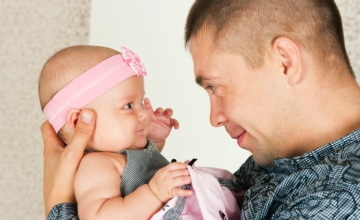Learn how to nurture your baby’s social, emotional, intellectual, language, and motor development from 6 to 9 months. Explore more age ranges in our full Healthy Minds Series.
This handout is based on findings reported in From Neurons to Neighborhoods: The Science of Early Childhood Development* from the National Academy of Sciences that examined child and brain development in the early years. The information we offer is age-specific, summarizes key findings from the report, and suggests how you might be able to use these key findings to nurture your own child’s healthy development.
Key Findings
Findings in From Neurons to Neighborhoods: The Science of Early Childhood Development include:
- Your relationship with your child is the foundation of her healthy development.
- Your child’s development depends on both the traits he was born with (nature), and what he experiences (nurture).
- All areas of development (social, emotional, intellectual, language, and motor) are linked. Each depends on, and influences, the others.
- What children experience, including how their parents respond to them, shapes their development as they adapt to the world.
How Development Looks in Everyday Life
This example shows how all areas of Jenna’s development are connected and how her mother’s response supports her healthy development.
Jenna’s strong bond with her mother, the trust she shows as she clings to her for safety, and her fear of strangers are all signs of her social and emotional development.
Relationships are the foundation of a child’s healthy development.
Her intellectual development enables her to tell the difference between who she knows and who she doesn’t, and it helps her take steps to get the comfort and protection she wants. She uses her sounds (language development) and facial expressions and gestures (motor development) first to communicate to Anne that she is uncomfortable and wants support. Later she uses them to communicate that she is ready to interact. Anne’s sensitivity to Jenna’s need to warm up slowly to new situations and people helps Jenna feel loved and secure, which will help her feel more comfortable meeting new people as she grows.
Charting Your Child’s Healthy Development
The following chart describes many of the things your baby is learning between 6 and 9 months and what you can do to support your child in all areas of her development. As you read, remember that children develop at their own pace and in their own way. Understanding who your child is, what her strengths are, and where she needs more support are essential for promoting her healthy development. If you have questions regarding your child’s development, ask your pediatrician.
| What’s going on: | What you can do: | Questions to ask yourself: |
|---|---|---|
| Babies this age are big communicators. They use many sounds, gestures, and facial expressions to communicate what they want. | Talk a lot with your baby. For example, label and narrate. “You’re eating a big banana!” Give her time to respond. | How does your baby let you know what she wants? What she’s feeling and thinking? |
| Their actions are their communications. They may be starting to put consonants and vowels together to form words like “dada” and “mama.” | Respond to her communications. See how long you can keep a back-and-forth conversation going. For example, she makes a sound, you imitate it, she makes another sound, and so on. | What, if anything, do you find frustrating about understanding your baby’s communications? Why? |
| As her brain grows, your baby will start to imitate others, especially you. This leads to the development of lots of new skills. | Give your baby time to take in what you did and then copy you. Push a button on the jack-in-the-box, then wait for your baby to do it before you do it again. This teaches your baby cause and effect. Seeing that she can make things happen builds her self-confidence and makes her want to take on new challenges. | How have you seen your baby imitate? |
| Babies this age can also use toys in more complex ways. For example, instead of just holding a plastic cup, a baby this age may use it to pour water in the bathtub. | Provide a variety of safe toys for the bath—containers, rubber toys, plastic bath books, and plastic ladles. These will encourage your baby to explore and experiment with the different ways to use objects. Of course, never leave your baby alone in the bath. | What kind of play does your baby most enjoy? What does this tell you about her? |
| Their motor skills allow them to make the ideas in their head happen, for example, getting the ball that rolled away. | Create an environment that is safe for exploration. Make sure only safe objects are within your baby’s grasp, and that anything she might use to pull herself up to her feet is sturdy and fastened down to the floor or wall. This kind of baby-proofing of your house also will reduce conflicts between you and your baby. | What do you need to do to make your home safer for your “little explorer?” |
*About “From Neurons to Neighborhoods”
The report From Neurons to Neighborhoods: The Science of Early Childhood Development was a 22-year effort by a group of 17 leading professionals with backgrounds in neuroscience, psychology, child development, economics, education, pediatrics, psychiatry, and public policy. They reviewed what was known about the nature of early child development and the influence of early experiences on children’s health and well-being. The study was sponsored by a number of federal agencies and private foundations.
Download the PDF to view the original handout
Healthy Minds_ Nurturing Your Child’s Development From 6 to 9 Months




